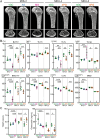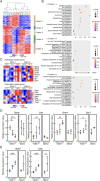Impact of microgravity and lunar gravity on murine skeletal and immune systems during space travel
- PMID: 39567640
- PMCID: PMC11579474
- DOI: 10.1038/s41598-024-79315-0
Impact of microgravity and lunar gravity on murine skeletal and immune systems during space travel
Abstract
Long-duration spaceflight creates a variety of stresses due to the unique environment, which can lead to compromised functioning of the skeletal and immune systems. However, the mechanisms by which organisms respond to this stress remain unclear. The present study aimed to investigate the impact of three different gravitational loadings (microgravity, 1/6 g [lunar gravity], and 1 g) on the behavior, bone, thymus, and spleen of mice housed for 25-35 days in the International Space Station. The bone density reduction under microgravity was mostly recovered by 1 g but only partially recovered by 1/6 g. Both 1 g and 1/6 g suppressed microgravity-induced changes in some osteoblast and osteoclast marker gene expression. Thymus atrophy induced by microgravity was half recovered by both 1 g and 1/6 g, but gene expression changes were not fully recovered by 1/6 g. While no histological changes were observed due to low gravity, alterations in gene expression were noted in the spleen. We found that in bone and thymus, lunar gravity reduced microgravity-induced histological alterations and partially reversed gene expression changes. This study highlighted organ-specific variations in responsiveness to gravity, serving as an animal test for establishing a molecular-level gravity threshold for maintaining a healthy state during future spaceflight.
Keywords: Bone; Gene expression; Microgravity; Spaceflight; Spleen; Thymus.
© 2024. The Author(s).
Conflict of interest statement
Competing interests: The authors declare no competing interests.
Figures





References
-
- Witze, A. Lift off! Artemis Moon rocket launch kicks off new era of human exploration. Nature611, 643–644. 10.1038/d41586-022-02310-w (2022). - PubMed
-
- Vandenburgh, H., Chromiak, J., Shansky, J., Del Tatto, M. & Lemaire, J. Space travel directly induces skeletal muscle atrophy. FASEB J.13, 1031–1038. 10.1096/fasebj.13.9.1031 (1999). - PubMed
-
- Grimm, D. et al. The impact of microgravity on bone in humans. Bone87, 44–56. 10.1016/j.bone.2015.12.057 (2016). - PubMed
MeSH terms
Grants and funding
LinkOut - more resources
Full Text Sources

